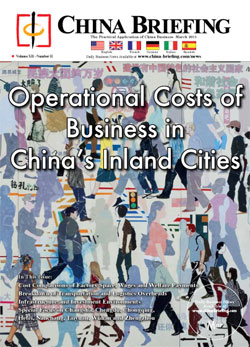New Issue of China Briefing: Does it Make Economic Sense to Locate Inland?
 First tier cities compared with the inland provincial capitals of Changsha, Chengdu, Chongqing, Hefei, Nanchang, Taiyuan, Wuhan and Zhengzhou
First tier cities compared with the inland provincial capitals of Changsha, Chengdu, Chongqing, Hefei, Nanchang, Taiyuan, Wuhan and Zhengzhou
Mar. 1 – The new issue of China Briefing Magazine – out today – is dedicated to analyzing the costs of doing business in China’s inland cities compared to their coastal counterparts.
Taking the cities of Beijing, Shanghai, Guangzhou and Shenzhen as primary benchmarks, this issue examines the related costs of factory rental, land acquisition, wages, welfare payments, logistics (including rail transportation costs to the nearest port), and compares these to cities in coastal second tier cities – Jiangsu, Zhejiang – as well as the inland provincial capitals of Anhui, Hebei, Henan, Hunan, Jiangxi, Sichuan, Shanxi, in addition to Chongqing.
A closer look at the inland cities of Changsha, Chengdu, Chongqing, Hefei, Nanchang, Taiyuan, Wuhan and Zhengzhou, including local economy, applicable investment zones, and infrastructure is also included. All statistics and analysis have been prepared especially for this issue with the help of Dezan Shira & Associates, CBRE, and Asia Pacific Properties.
This issue of China Briefing discusses the total operational cost savings of locating inland – perhaps up to 50 percent overall – and will help China manufacturers establish the foreign investor make informed decisions on which cities offer the most appropriate business environment to host their operations.
The issue is available from the China Briefing bookstore, priced at US$10. Please click on the cover image at the top of the page for more details.
Related Reading
China Briefing has published a number of business investment guides to China, collectively covering the entire country. Each guide details local demographics, economies, complete business costings, investment zones, infrastructure, and available incentives to the foreign investor. All are priced at US$40 for the immediate PDF download.
 Business Guide to Shanghai and the Yangtze River Delta (third edition)
Business Guide to Shanghai and the Yangtze River Delta (third edition)
188 pages. A complete overview of Shanghai and the Yangtze River Delta, including the provinces of Anhui, Jiangsu, Shanghai and Zhejiang, and with detailed introductions to the cities of Changshu, Changzhou, Hangzhou, Hefei, Huzhou, Jiangyin, Jiangxi, Kunshan, Nanjing, Nantong, Ningbo, Shanghai, Shaoxing, Suzhou, Taicang, Taizhou, Wenzhou, Wuxi, Yangzhou, Yiwu, Zhangjiagang, Zhenjiang and Zhoushan.
 Business Guide to South China and the Pearl River Delta (second edition)
Business Guide to South China and the Pearl River Delta (second edition)
196 pages. A full description of South China, including Hong Kong, Macau, and the provinces of Guangdong, Fujian, Guangxi and Hainan, in addition to detailed introductions to the cities of Dongguan, Foshan, Fuzhou, Guangzhou, Haikou, Huizhou, Nanning, Shantou, Shenzhen, Xiamen, Zanjiang, Zhaoqing, Zhongshan and Zhuhai.
 Business Guide to Beijing and Northeast China (second edition)
Business Guide to Beijing and Northeast China (second edition)
184 pages. Detailing Beijing and Northeast China, including the provinces of Hebei, Heilongjiang, Jilin, Liaoning and Shandong, and with expansive introductions to the cities of Anshan, Beijing, Changchun, Dalian, Dandong, Harbin, Jinlin, Jinan, Shenyang, Shijiazhuang, Qingdao, Qinhuangdao, Tianjin, Weihai, Yantai and Zibo.
 Business Guide to Central China
Business Guide to Central China
120 pages. A comprehensive introduction to Central China, including the provinces of Hebei, Henan, Hubei, Inner Mongolia, Jiangxi and Shanxi, and includes detailed introductions to the key cities of Baotou, Chengde, Changsha, Datong, Hohhot, Kaifeng, Luoyang, Manzhouli, Nanchang, Taiyuan, Wuhan, Yichang and Zhengzhou.
 Business Guide to West China
Business Guide to West China
172 pages. This book is a detailed overview of West China, including the provinces of Gansu, Guizhou, Ningxia, Shaanxi, Sichuan, Tibet, Xinjiang and Yunnan, and includes detailed introductions to the key cities of Chengu, Chongqing, Kashgar, Kunming, Lanzhou, Lhasa, Guiyang, Urumqi, Xining and Yinchuan.
 Business Guide to China’s Second and Third Tier Cities
Business Guide to China’s Second and Third Tier Cities
217 pages. The guide book is the definitive guide to China’s second and third-tier cities. It provides a thorough and in-depth analysis, regional intelligence and overviews of fifty of China’s emerging cities, featuring economic data, infrastructure and investment climate reviews, and a directory to development zones, business associations, media and major hotels in all locations.
- Previous Article China-India Weekly Business Update: March 1
- Next Article Best Buy’s Withdrawal: American Morals Fail to Transcend Chinese Consumer Market
























